ECS P67H2-A Review: A visit back to Lucid's Hydra
by Ian Cutress on July 21, 2011 9:00 AM EST- Posted in
- Motherboards
- Lucid
- P67
- ECS
For those who have never come across Lucid Hydra before, at release, it was heralded as the end of all other multi-GPU solutions. Using this hardware and software interface, all DirectX and OpenGL calls would be intercepted and managed between the GPUs available on board, regardless of manufacturer, make, model, power, memory size, everything. In reality, things were tougher than they seem.
I'm not going to speak about how Hydra works in detail - Ryan's tests and explanation have covered that in significant detail. Today, I'm purely looking at how it performs in the market against some of the current retail titles, and how well the solution works.
ECS provide the Hydra software on the CD in the motherboard set, but unfortunately this is the 1.6.1 version, which predates October 2010. The latest edition is available from the LucidLogix website, and currently rings in at version 1.7.105. This version is still a few months old though, and it shows. With the Hydra solution, you are limited to which drivers can be used - in terms of NVIDIA, the latest compatible drivers are 266.58, and with AMD it is the 11.3 ones you have to use.
The Hydra solution supports most combinations of AMD and NVIDIA hardware - NVIDIA support is for the GF 9xxx, 2xx, 4xx and 5xx series (excluding GTX 295 and GTX 590), AMD support is for the HD 4xxx, 5xxx and 6xxx series (except HD 5970 and HD 6990). Within this hardware list, Hydra only supports similar performance configurations - otherwise the overhead of supporting a powerful GPU and a HTPC GPU may be more than what the HTPC GPU can offer. Here are the diagrams Hydra provide in their documentation:
AMD+AMD:
NVIDIA+NVIDIA:
AMD+NVIDIA:
The Hydra solution is limited in other ways as well. The idea for this was that it would automatically intercept calls to the graphics cards and distribute the work accordingly. In reality, the Hydra software needs to be told which programs to intercept, and the way it is performed is actually misleading. The software itself will list 200+ games and benchmarks that Hydra will detect, but the Hydra system will actually only work with 43 according to the documentation. These are, in alphabetical order:
1. 3DMark 11
2. 3DMarkVantage
3. 3DMark 06
4. Aliens vs Predators
5. Aliens vs Predators benchmark
6. Batman: Arkham Asylum
7. Burnout Paradise ultimate
8. Call of Juarez
9. Company of Heroes
10. Cryostasis
11. Crysis Warhead
12. Devil May Cry 4
13. Devil May Cry 4 Benchmark
14. Fallout 3
15. Far Cry 2
16. Fear 2
17. Hawx
18. Call of Duty: Black Ops
19. Call of Duty: Modern Warfare – Single Player
20. Call of Duty: Modern Warfare – Multi Player
21. Call of Duty: Modern Warfare 2 - Single Player
22. Call of Duty: Modern Warfare 2 - Multi Player
23. Jericho
24. Left 4 Dead
25. Left 4 Dead 2
26. Mini Ninjas
27. Operation Flashpoint Dragon Rising
28. Prince of Persia: The Forgotten Sands
29. Resident Evil 5 Japanese (Biohazard)
30. Resident Evil 5
31. Stone Giant
32. Stormrise
33. Supreme Commander
34. Supreme Commander 2
35. The Witcher - enhanced
36. Tomb Rider
37. Trackmania Forever
38. Trackmania Nations
39. Velvet Assassin
40. Unigine Heaven 2.1
41. Wanted Weapons of Fate
42. World in Conflict
43. Wolfschanze 2
This is rather disappointing. Using the Hydra solution as an SLI certification bypass doesn't really work if there are only this many applications that the system supports.
Nevertheless, we've tested it on a few programs - Alien vs. Predator, Hawx, Far Cry 2, and a synthetic, 3D Mark Vantage. I've put a synthetic in there for one reason - it should give an indication of the maximum performance a combined multi-GPU setup should give. A synthetic doesn't really mimic real-world performance, as the algorithms used in them will try and use all the GPU capabilities all the time, but as an upper rung it might be worth taking a look.
For the tests, ECS provided us with a pair of their GTX 580 GPUs, which are the default factory versions with ECS stickers. Using these in conjunction with a pair of HD 5850s allows the following GPU combinations:
| GPU 1 | GPU 2 | GPU 3 | Hydra / CrossFire |
| 580 | |||
| 5850 | |||
| 580 | 580 | Hydra | |
| 5850 | 5850 | Hydra | |
| 5850 | 5850 | CrossFire | |
| 580 | 5850 | Hydra | |
| 5850 | 580 | Hydra | |
| 580 | 5850 | 5850 | Hydra |
| 5850 | 580 | 5850 | Hydra |
| 5850 | 5850 | 580 | Hydra |
| 5850 | 580 | 580 | Hydra |
| 580 | 5850 | 580 | Hydra |
| 580 | 580 | 5850 | Hydra |
The reason for doing combinations such as 580+5850+5850, 5850+580+5850 and 5850+5850+580 are both for compatibility and to see if moving PCIe slots (and going from 16x to 8x lanes) makes a difference. Hypothetically speaking, we would expect the system to work best when the most powerful cards are first in the list.
3DMark Vantage
Now for some results - first, 3DMark Vantage. Here we take the GPU score of the benchmark:
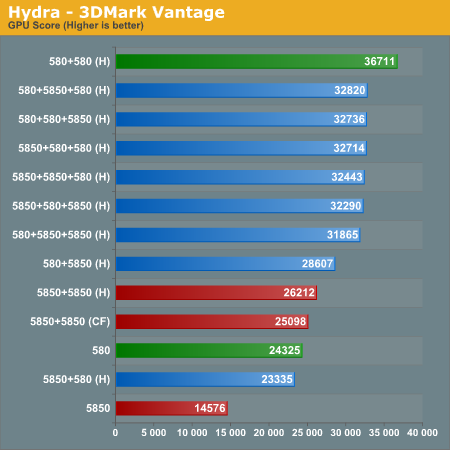
Quite a few issues come through here:
- A single 580 is better than a 5850+580 combination in Hydra
- The 580+5850 combination outperforms the 5850+580 due to the more powerful card being first
- 5850+5850 in Hydra beats the same combination in CrossFire
- All the three card setups perform roughly the same.
- Two 580s in Hydra outperform all the three card setups.
Aliens vs. Predator
For DirectX11, we've taken the Aliens vs. Predator benchmark, and run through the GPU combinations:
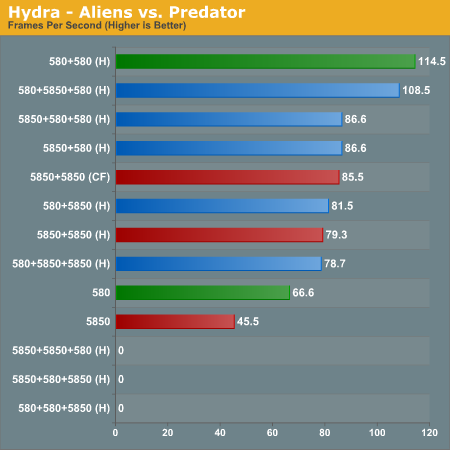
This time, other issues arise:
- When using two 5850s in a three card setup, if a 5850 was in the first slot, the program would not recognise the 580 and run in AMD only mode.
- A similar occurrence happened when two 580s were used with a 5850, but only when the 5850 was in slot three. In this configuration, the application would run in NVIDIA only mode.
- The 5850+580+580 mode gave the same value as the 5850+580 mode, suggesting the third GPU was not detected properly by Hydra.
- The 5850+5850 Crossfire combination beat the 5850+5850 Hydra score, unlike in 3DMark Vantage.
- The 580+5850+580 three card setup outperformed all the other three card setups, but was still beaten by two 580s in Hydra mode.
Hawx:
For a real world DirectX10 benchmark, we chose Hawx, the action/flight simulator. Using the internal benchmark in DirectX 10.1 mode, with all the settings turned up to max at 1920x1080, the following results were achieved:
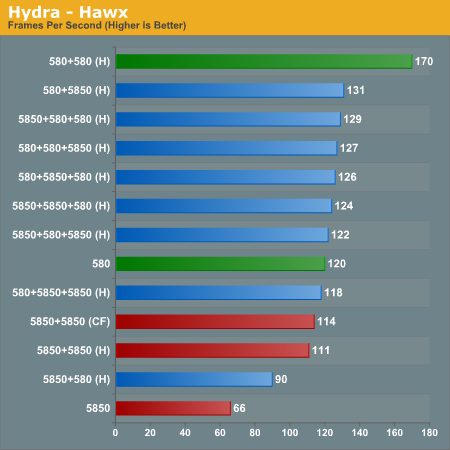
Unfortunately, there were quite a few issues running Hawx in many of the modes. In all the three card modes, some long distance texture flickering was observed:
- 5850+580 Hawx: flickering
- 5850+580+580 Hawx: flickering
- 5850+580+5850 Hawx: flickering
- 5850+5850+580 Hawx: flickering
- 580+5850+5850 Hawx: flickering
- 580+580+5850 Hawx : flickering
- 580+5850+580 Hawx: stutter, flickering
Ultimately, all these three card modes performed similarly anyway (118 -129 FPS). The dual 580 Hydra still comes top here, but the 580+5850 setup beats all the three card setups as well.
FarCry 2:
Our last test was FarCry 2, using the built-in GPU benchmark, looped 4 times and an average taken. Unfortunately, despite being a supported application on the Hydra platform, results were very poor all around:
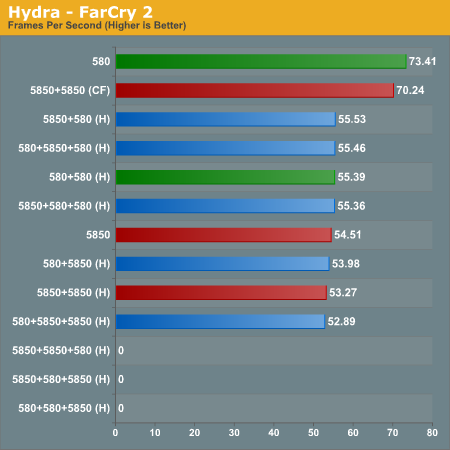
The issues found in Aliens vs. Predator with combination card setups running in AMD or NVIDIA mode surfaced here as well. But even more astonishing is that every Hydra setup failed to give a boost in performance. It seems that they have all defaulted to a 5850 - and even the dual 580 Hydra setup performed worse than a single 580. The only card combinations worth working were the single card setups and the two 5850s in Crossfire.
Conclusions
The Hydra solution is still a long way from being viable and commonplace on motherboards. It is a sneaky way around SLI certification, but only on a few products. As it also supplies some extra PCIe lanes to run in x16/x16 or x16/x8/x8 mode, it makes me wonder if the price of the Hydra chip is cheaper than SLI certification and the NF200. Nevertheless, the software needs both a driver update as well as a longer list of working titles. However I fear that Lucid are more preoccupied with their Virtu technology on Z68, rather than Hydra.



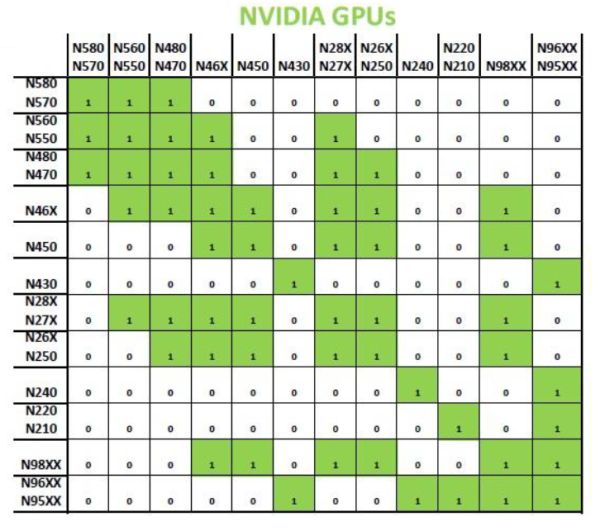
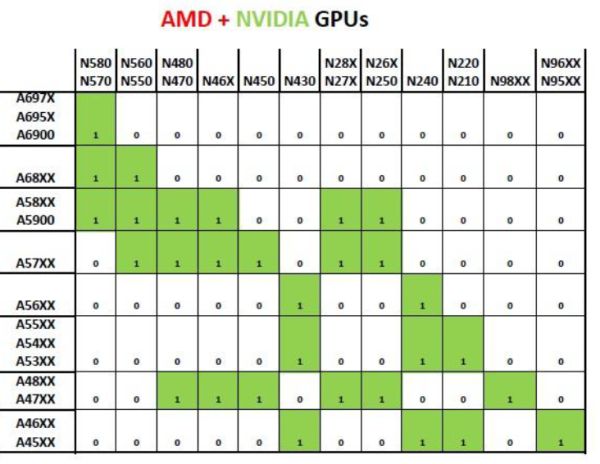








22 Comments
View All Comments
MWilliamson - Thursday, July 21, 2011 - link
An excellent review Ian; I'm impressed by how many combinations you tested under Hydra. While I'm currently not looking to build another system, I have found Hydra to be an interesting concept, and I'm waiting for it to mature to the point where it is valid for all configurations.What I wished to comment on though, was your comment in the Gaming Benchmarks:
"Metro 2033 is the Crysis of the DirectX 11 world (or at least until Crysis 2 is released)..."
Crysis 2 HAS been released, and has been available since April. Granted at the time of release it did not support DirectX 11, due largely in part to it being launched simultaenously on PC and consoles, a recent patch (released June 27th) has added its DirectX 11 feature set, and another patch increased the texture quality for PC gamers, both of which are actually optional, free upgrades. The most recent version, 1.9, also added a demo level which can be run via the in-game console; personally I have no experience with that side of things, since I played through for the storyline, but it is there, and I'd imagine its something you could add to your benchmarking suite, should it suit whatever your requirements are.
IanCutress - Thursday, July 21, 2011 - link
Many thanks on the update :) Not had much time to play games recently, but at some point I want to update the GPU drivers in my reviews also. Updating GPU drivers essentially removes all previous GPU results, so it might be worth having a look at the games I test as well at the same time.Ian
MWilliamson - Thursday, July 21, 2011 - link
You're most welcome, I had thought that was a possibility :)Igen - Thursday, July 21, 2011 - link
Hard to tell from the pics, but are those heatsinks riveted on? Would make mods/repairs difficult.DanNeely - Thursday, July 21, 2011 - link
The southbridge sink has what look like plastic fasteners; I'd assume they're pushpins of some sort. The moftset/etc sinks are harder too tell because of the angle and not being perfectly in focus, but if you look at the fastener in the lower right on the 5th pic the recessed area shows two indents that look like they're in the right spots to be part of a philips head which is otherwise out of sight. A high resolution vertical image/bottom image would really help.Uritziel - Friday, July 22, 2011 - link
MOFTSET lol! I'm going to start saying that :)Death666Angel - Thursday, July 21, 2011 - link
The green color of the ECS mainboard bars in the graphs for gaming makes little sense here, because then we don't know which resolution was used, as the resolution is identified as the colors. Though of course the higher resolution has most likely the lower fps numbers, it still looks odd. :-)Good review though!
HangFire - Thursday, July 21, 2011 - link
You got 3? Wow. My old ECS C2D board had one (two if you count the CPU).ECS has really moved up over the years.
fausto412 - Thursday, July 21, 2011 - link
this solution is junk.dhiiir - Friday, July 22, 2011 - link
I believe that the best motherboard can be ruined with a terrible BIOS or UEFI. UEFI is pretty cool, but if you can't make a good text only implementation, how the hell are you going to make a passable GUI? I'm perfectly happy with a well designed text based UEFI, but I will admit that as much time as I spend with BIOSs and UEFIs, Asus' slick GUI system is clearly in a class by itself. If I were new to the game, I would want something like that on my first build. There just isn't an excuse for terrible BIOS/UEFIs in the year 2011.I like online shopping,but don't know where have a good store to buy . I have a friend said that a shop is very good. -.www.upsfashion.com- I went. Really good. Things are cheap, fashion,. Owner has a good attitude. I am really happy to buy things there.